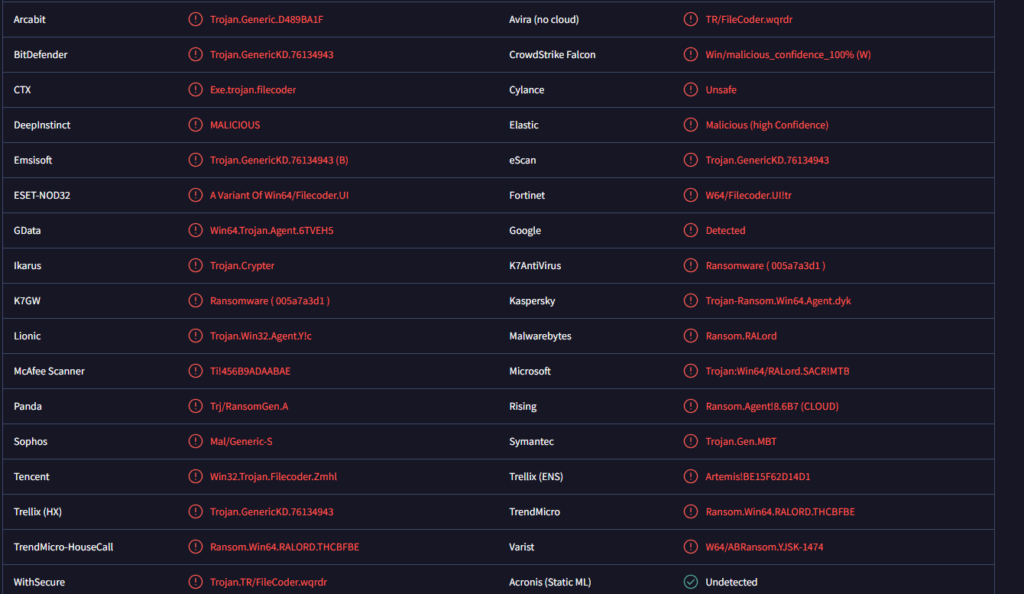Remove RALord ransomware
RALord ransomware is file-encrypting malware that, unfortunately, targets all important files. The ransomware can be identified by the .RALord extension it adds to files it encrypts. If your files have been encrypted by this ransomware, you will not be able to open them unless you first use a decryptor on them. However, obtaining a decryptor is not going to be easy, as the only ones who have it are the cybercriminals operating this ransomware. They will demand payment, but even if you pay, a decryptor is not guaranteed.
RALord ransomware is designed to encrypt all of your personal files, such as photos, videos, documents, and more. Once encrypted, these files will have the .RALord extension attached to them. This will help you identify which files have been compromised. For example, if image.jpg was encrypted, it would become image.jpg.RALord. Without a decryptor, you won’t be able to open these files.
Ransomware operators will demand payment for the decryptor, and they provide instructions in the README-[random_string].txt ransom note, which gets dropped after the encryption process is complete. Although the note does not specify the ransom amount, it provides details on how to contact the malware operators.
We strongly advise against paying the ransom, no matter what the ransom amount is. While ultimately it’s your decision, it’s important to weigh the risks. You have no guarantees that you will receive the decryption tool after making a payment. Dealing with cybercriminals leaves you vulnerable to the possibility of losing your money without obtaining the decryptor. What’s more, one contributing factor to the rise of ransomware is that many victims choose to pay the ransom.
If you regularly back up your important files, recovery shouldn’t be too difficult. However, be sure to remove RALord ransomware from your system first. Connecting to your backup while the ransomware is still active could lead to the encryption of those backup files as well. To safely remove RALord ransomware, we recommend using anti-virus software and not attempting manual removal, as this could cause more harm.
For those without backups, recovering files can be much harder. Occasionally, security experts and malware researchers may release free decryptors to help victims, but this is not guaranteed.
How did ransomware enter your computer?
Malicious spam emails are often used by cybercriminals to spread malware. Cybercriminals buy victims’ email addresses from various hacking forums and launch massive spam campaigns with emails that have malware attached to them. If users open these files, the malware can execute. Fortunately, by learning to identify malicious emails, you can significantly lower your risk of infection.
One thing about a lot of malicious emails is their tendency to have a lot of grammar and spelling mistakes. The mistakes are very obvious because senders claim to be from legitimate and known companies. What’s more, malicious emails use generic words like “User”, “Member”, or “Customer” instead of addressing recipients by name, despite often claiming to be from companies whose services recipients supposedly use. In contrast, legitimate emails from companies you have interacted with are usually well-written and use your name to address you. However, it’s worth mentioning that some more sophisticated malspam can appear quite legitimate, so it’s a good idea to run any unsolicited email attachments through anti-virus software or VirusTotal before opening them.
Downloading pirated content through torrents is another way many users pick up malware infections. Torrent sites are often poorly regulated, making it simple for cybercriminals to include malware in torrents for popular movies, TV series, video games, or software. Pirating copyrighted content is not only content theft, it’s also potentially dangerous for your computer/data.
These examples are just a few common methods used to spread ransomware. Infections can also come from downloads from unreliable sources, clicking on deceptive ads, or visiting high-risk websites. By adopting safer browsing habits, you can greatly minimize your chances of encountering malware in the future.
How to remove RALord ransomware
Because ransomware infections are sophisticated infections, using an anti-malware to remove them is necessary. Use a reliable anti-malware program to remove RALord ransomware. Keep in mind that you should not connect to your backup until you are completely certain that the ransomware has been eliminated. Otherwise, your files in backup may be encrypted as well.
Once you fully remove RALord ransomware, you can begin restoring your files from the backup. If backup is not an option for you, your only option is to back up the encrypted files and wait for a free RALord ransomware decryptor to be released.
Site Disclaimer
WiperSoft.com is not sponsored, affiliated, linked to or owned by malware developers or distributors that are referred to in this article. The article does NOT endorse or promote malicious programs. The intention behind it is to present useful information that will help users to detect and eliminate malware from their computer by using WiperSoft and/or the manual removal guide.
The article should only be used for educational purposes. If you follow the instructions provided in the article, you agree to be bound by this disclaimer. We do not guarantee that the article will aid you in completely removing the malware from your PC. Malicious programs are constantly developing, which is why it is not always easy or possible to clean the computer by using only the manual removal guide.

